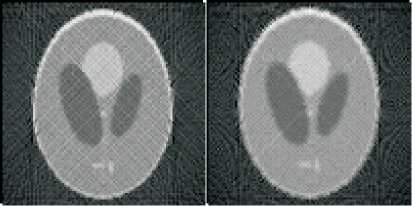Learning and Nonlinear Models - Revista da Sociedade Brasileira de Redes Neurais, Vol. 1, No. 2, pp. 122-130, 2003
© Sociedade Brasileira de Redes Neurais
For fan-beam geometry, the projections (in this case named p’) need to be multiplied by an adjust function, before the
filter [7]:
p ( n, θ) = p ' ( n, θ) D
(21)
(22)
DD2 + n2
After the compensation, the convolution is carried out with a slight modification in the filter coefficients:
n=0
n even
n odd.
1
∕8,
h ( n ) = -∣0,
-1
The full reconstruction process consists on the two neural networks (filtering and backprojection) connected in
cascade. The output of filtering network is connected to the input of backprojection network. This can also be seen as a single
two-layer neural network and it could be implemented in an appropriate neural hardware.
3. Results
The proposed neural network was implemented in C++ and executed in a sequential processor for verification purposes. We
compared the times for reconstruction with and without interpolation (and fan-beam). The experiment was run on a
microcomputer with Pentium 1.6 MHz processor. The times were obtained from an average of 1000 algorithm runs. Table 1
lists the execution times for conventional backprojection algorithm and for neural network where the time to build the network
(calculate the weights) and the time to process the reconstruction were measured separately.
|
conventional |
partially connected neural network | |||||
|
parallel |
fan-beam |
parallel |
fan-beam | |||
|
build |
run |
build |
run | |||
|
no interpolation |
293 |
512 |
250 |
57 |
524 |
57 |
|
with interpolation |
369 |
707 |
347 |
108 |
656 |
108 |
Table 1 - Execution times (in milliseconds) for neural network and
conventional backprojection reconstruction of images with 100x100 pixels
Total time to reconstruct one image is greater for neural network but once the network has been assembled the time to
compute the reconstruction is very small. Network approach has noticeable advantages when several sections from an object
need to be reconstructed in sequence, like in a 3-D representation. For example, reconstruction of 10 slices by conventional
backprojection with fan-beam geometry would take 5.1s while the network would be constructed once and executed 10 times
in 1.1s, almost 5 times faster.

(α) (b)
Figure 8: Sheep-Logan phantom reconstructed with dimension 100x100 by neural network, (a) without interpolation and (b)
with interpolation.
In figure 8 reconstructed images without (a) and with (b) interpolation are shown. When interpolation is used a
smother image with less artifacts is achieved. To compare image quality we computed its peak signal to noise ratio (PSNR)
defined as the peak amplitude of the original phantom divided by the difference between original phantom and reconstructed
image expressed in dB. Figure 9 shows a plot of PSNR as a function of the number of (FIR) filter coefficients use in the
128
More intriguing information
1. The name is absent2. A MARKOVIAN APPROXIMATED SOLUTION TO A PORTFOLIO MANAGEMENT PROBLEM
3. The name is absent
4. Announcement effects of convertible bond loans versus warrant-bond loans: An empirical analysis for the Dutch market
5. Heavy Hero or Digital Dummy: multimodal player-avatar relations in FINAL FANTASY 7
6. The name is absent
7. Epistemology and conceptual resources for the development of learning technologies
8. The name is absent
9. Spectral density bandwith choice and prewightening in the estimation of heteroskadasticity and autocorrelation consistent covariance matrices in panel data models
10. Does South Africa Have the Potential and Capacity to Grow at 7 Per Cent?: A Labour Market Perspective